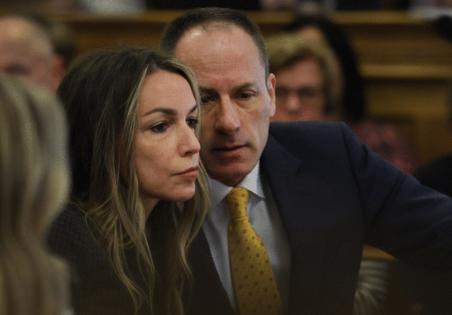Karen Read retrial jurors released for day despite note suggesting they were near verdict
Published in News & Features
DEDHAM, Mass. — The Karen Read retrial jury was released shortly before 4 p.m. Tuesday even though a note they sent earlier in the day suggested that they were nearing a verdict.
“If we find not guilty on two charges but can’t agree on one charge, is it a hung jury on all three charges or just one charge?” the jury asked in a question read by Judge Beverly J. Cannone following the lunch recess.
After some back and forth, Cannone decided to respond, “This is a theoretical question, not one that I can answer.” She said that it is important that jurors not consider implications of their decision while reaching a verdict.
Defense attorney Alan Jackson said that the response is “over our objection.”
“I don’t think that’s an appropriate answer to a very, very clear question that could be answered in an innocuous way that does not affect Ms. Read’s rights. This way it does,” Jackson said.
Just before lunch, the jury sent its first note of the trial, which turned out to be three questions. It led to the verdict slips being amended after all, which the defense had requested earlier.
“What is the time frame for the OUI charge?” the jury’s first question stated as read by Cannone. “Second, are video clips of Karen’s interviews evidence? How should we consider them? And the third, does guilty on a subcharge mean guilty on the overall charge?”
Jurors have deliberated since closing arguments ended on Friday. They deliberated for about 1 hour and 45 minutes that first day, made it to about 9 hours by the end of Monday and had reached nearly 11 hours when they announced they had a question.
Cannone asked attorneys to consult for 20 minutes and then argue for how she should answer these questions.
Question discussions
For question 1, the OUI time frame, defense attorney Alan Jackson suggested that Cannone tell the jurors “you are the factfinder.” Prosecutor Hank Brennan suggested she tell them “12:45” a.m., as that is around the time of the alleged vehicle strike.
Cannone said “if it’s not in the indictment I’m not comfortable telling them a time.” It was not in the indictment, so Cannone sided with the defense.
For question 2, the video clips of Read, Cannone ruled that she will tell them “yes, the videos are evidence. You should weigh the defendant’s statements as you would any other piece of evidence and give them the weight you deem appropriate.” She didn’t tack on “if any” as the defense requested.
For question 3, whether a guilty vote on a subordinate charge to OUI manslaughter makes her guilty of the primary charge, Jackson said “the answer is no, obviously” and suggested that new verdict slips be issued that make that clear.
He suggested that the court add the language “if you find the defendant not guilty of the offense charged or any lesser included offense stop, comma, and sign the verdict slip.” He said it’s the only place it doesn’t appear.
Brennan said he doesn’t disagree with the defense’s edit suggestions. He said that direct explanation to the jury is not necessary and the edits are sufficient.
Cannone agreed to make some clearer amendments to the verdict slip.
“What I planned on doing is bringing them out and giving them each a copy of the amended verdict slips and explaining that it really is consistent with the jury instructions I gave them, but walking them through it,” Cannone said. “So we start from the top and say if you find the defendant guilty, stop, you’re done. Sign the verdict slip and let the court officer know you have a verdict. … ”
The rest went unsaid in court but the defense seemed happy with the plan.
Cannone’s decision on the second question of the day, about whether indecision on one count means a hung jury for all counts, had some trial observers scratching their heads. Retired state Superior Court Judge Jack Lu tried to explain what Cannone’s thought process was.
“This is a super sensitive time,” he said, adding that he agreed with Cannone’s decision. “The judge must not do anything that might unintentionally influence the jury’s verdict.”
“This means no answers to hypothetical questions. No answers to results-oriented or outcome-oriented questions,” he continued.
He offered an analogy using a different question that would require the same response: “If the jury said ‘What if we convict the defendant of OUI only? What is the possible sentence?’ The judge must say 'I will not answer the question.'”
Analyst says questions are good for defense
Lu found the questions leaned in favor of the defense. Here’s his breakdown of the three questions.
“Question number 1 is highly defense favorable. Question number 2 is neutral. Question number 3 is defense favorable,” he said.
He further said that the answers to each are “black-letter law.”
“There is no need for argument. The lawyers are over-trying the case,” he said.
The answer came following the Herald’s question about the third juror question. Lu agreed to the question’s premise that lesser included offenses, which can be found under the OUI manslaughter charge, are only to be considered if the jury does not find Read is guilty of OUI manslaughter but is guilty of a lesser related charge.
Those “lesser included” charges for OUI manslaughter on the verdict slip are involuntary manslaughter, motor vehicle homicide and operating under the influence of liquor.
Should the jury convict for only operating under the influence, the least serious of the lesser includeds, Lu said the sentence for a first-time offender like Read “would almost certainly be the ’24(d) program'” which includes outpatient treatment, loss of license and probation.
“It would be a big win for the defense,” he said.
_____
©2025 MediaNews Group, Inc. Visit at bostonherald.com. Distributed by Tribune Content Agency, LLC.







Comments